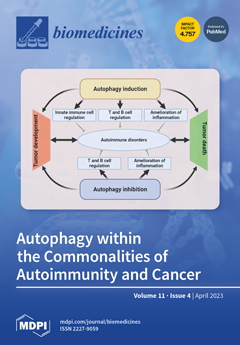Open AccessArticle
The Enhanced Expression of ZWILCH Predicts Poor Survival of Adrenocortical Carcinoma Patients
by
Małgorzata Blatkiewicz, Kacper Kamiński, Marta Szyszka, Zaid Al-Shakarchi, Anna Olechnowicz, Ewelina Stelcer, Hanna Komarowska, Marianna Tyczewska, Anna Klimont, Marek Karczewski, Tomasz Wierzbicki, Joanna Mikołajczyk-Stecyna, Marek Ruchała, Ludwik K. Malendowicz and Marcin Ruciński
Cited by 4 | Viewed by 2392
Abstract
Zwilch kinetochore protein (ZWILCH) plays a key role in proper cell proliferation. The upregulation of the
ZWILCH gene was observed in many types of cancers, but the association of ZWILCH with adrenocortical carcinoma (ACC) was not investigated so far. The main aim of
[...] Read more.
Zwilch kinetochore protein (ZWILCH) plays a key role in proper cell proliferation. The upregulation of the
ZWILCH gene was observed in many types of cancers, but the association of ZWILCH with adrenocortical carcinoma (ACC) was not investigated so far. The main aim of the presented study was to verify if the enhanced level of the
ZWILCH gene can be used as a diagnostic marker for ACC development and progression, as well as a predictor of survival time for ACC patients. The performed analyses included investigation of the
ZWILCH expression profile in tumors with publicly available TCGA (The Cancer Genome Atlas) datasets and transcriptomic data from the Gene Expression Omnibus (GEO) database, as well as, in human biological samples of normal adrenal, adrenocortical carcinoma and in commercially available tissue microarrays. The findings demonstrate statistically significant higher
ZWILCH gene expression in ACC tissue in comparison with normal adrenal glands. Furthermore, there is a strong correlation between
ZWILCH upregulation and tumor mitotic rate and the probability of patient survival. The enhanced
ZWILCH level is also connected with the activation of genes involved in cell proliferation and the inhibition of genes related to the immune system. This work contributes to a better understanding of the role of ZWILCH as an ACC biomarker and diagnostic tool.
Full article
►▼
Show Figures






